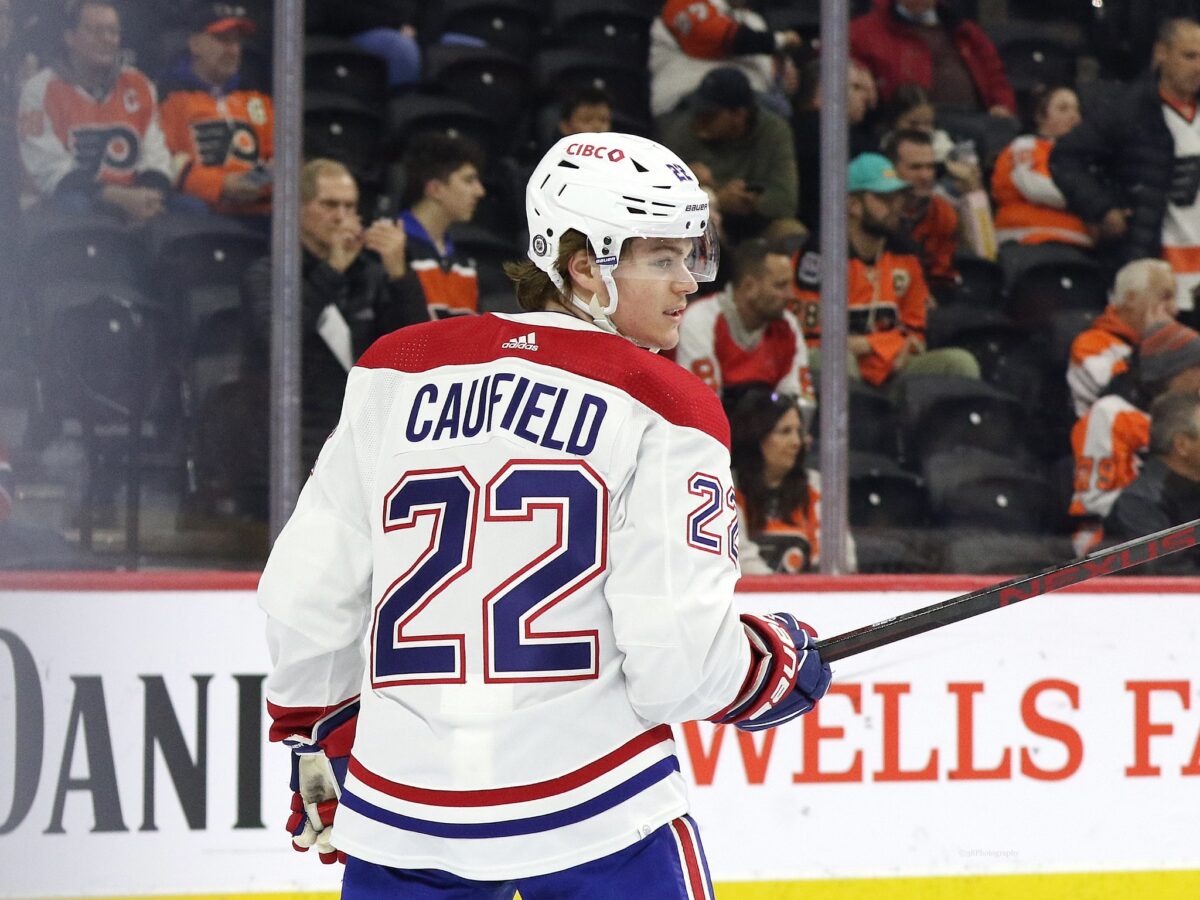It’s done!
After a few months of hand-wringing by the media and fans in Montreal, the Montreal Canadiens have extended restricted free agent (RFA) winger Cole Caufield. There was a concern as to whether he would get signed at all, with fears he could face an offer sheet. But after weeks of negotiating, general manager Kent Hughes and the Caufield camp have finally reached an agreement, as the diminutive forward has signed an 8-year deal with an AVV of $7.85 million.
Related: Predicting the Next Contract for Montreal Canadiens’ Cole Caufield
After what seemed like an eternity of waiting on the part of the fanbase, Hughes and the club announced that they had signed Cole Caufield to an eight-year deal worth $7.85 million per year.
The signing couldn’t have come at a better time. With Montreal in a rebuild, the focus for the management team has to be on the draft. And now that the most important piece of business for this offseason has been completed, Hughes can turn his attention to the draft, which is only a few weeks away.
Caufield’s Contract Structure
Per CapFriendly, Caufield has a modified no-trade list in the final three seasons of his contract, which is all he’s eligible for, given his unrestricted free-agent eligibility. The full breakdown of the contract is as follows:
2023-24: $4.975M base, $5M signing bonus
2024-25: $4.975M base, $5.5M signing bonus
2025-26: $9.975M base
2026-27: $8.705M base
2027-28: $6.215M base
2028-29: $5.985M base, 15-team no-trade list
2029-30: $5.985M base, 10-team no-trade list
2030-31: $5.985M base, five-team no-trade list
The structure of this contract demonstrates that Caufield is a significant part of the core group. It makes him one of the highest-paid players on the team, but the term and the no-trade clauses added to the final three years of the deal give him some measure of control as well.
Goal Caufield
If there is a skill set that is hard to find in the NHL, it’s goal scoring. Caufield has that, and despite any shortcomings, such as being 5-foot-7 and 174 pounds, it hasn’t stopped him from transferring that ability from one level of hockey to the next. In 123 NHL games, Caufield has scored 84 points, 53 of which are goals. However, since the arrival of head coach Martin St. Louis, Caufield has scored 48 goals in 83 games, showing that the two are an excellent fit stylistically.

Since Caufield’s 10-game debut in 2021, his goals per 60 minutes played 60 (1.26) ranks ninth in the NHL over that time. Also, despite missing 38 games due to a shoulder injury, he scored at an incredible rate this past season at 0.57 goals per game, placing him tenth in the NHL in 2022-23. Considering Caufield’s average ice time last season was 16:58 (with just under three minutes of that on the power play), his scoring rate has room to grow as his ice time increases.
Canadiens Set Core Price
This deal makes Caufield the second-highest-paid skater on the team next season, earning only $25,000 less than Nick Suzuki on the salary cap. As Caufield’s contract structure shows, the 22-year-old winger has been shown confidence by the management group. More importantly, it is a deal that helps the team create a new internal salary cap structure moving forward. It is clear that Hughes will be trying to keep any future salaries kept relatively close to those of their core pair. The Canadiens have committed to them, as a pair, until the 2029-30 season, with Caufield getting one extra year until 2031.
Signing Caufield to a contract below Suzuki’s allows the team to set its internal salary structure, which should provide some leeway under the cap to add significant players to take the team into a Stanley Cup contender status. Another reason this is a team-friendly deal is that the flat-cap era could end as soon as the summer of 2024, and according to CapFriendly’s projection, NHL teams could have as much as $87.5 million in 2024-25. That would mean the Habs have two top-line players taking up only 17.97 percent of the total cap. The cap is expected to continue to rise, projecting as much as $92.5 million in 2025-26, which lowers the total cap hit percentage for the pair to 17 percent. As the salary cap continues to rise, the better the value those contracts will provide.
Because of the term of the contracts, especially Caufield’s, and the expectation of rising salary cap ceilings over the term of the contract, the value will increase. But more so because the cap hit will remain relatively low, allowing space to maneuver, specifically over their prime playing years.
Hughes strategically signed one of the most underrated scoring forwards in the NHL to a team-friendly contract, but he also did something no GM has done in Montreal in decades. Hughes has identified a potential star, one that fans have begun to idolize, and ensured he would remain in Montreal for the long term. This not only shows the fans that Hughes can identify talent and negotiate a shrewd deal, but it also shows the league that Montreal will be a destination for free agents once again.
